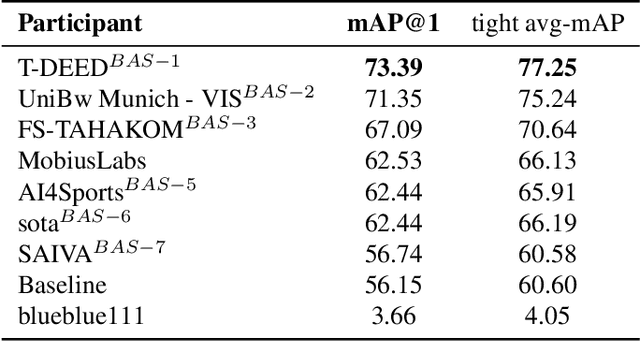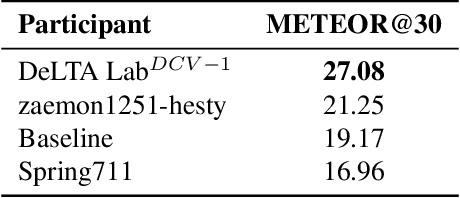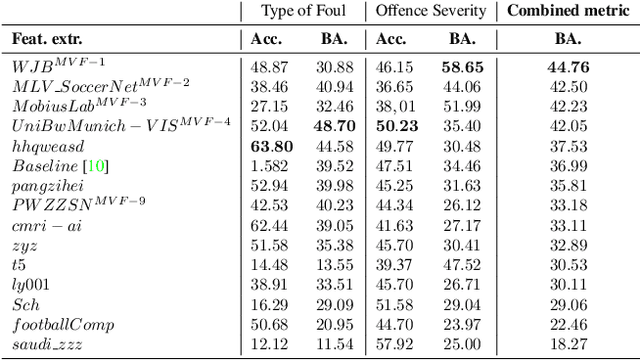Szymon Łukasik
Kolmogorov-Arnold networks for metal surface defect classification
Jan 10, 2025Abstract:This paper presents the application of Kolmogorov-Arnold Networks (KAN) in classifying metal surface defects. Specifically, steel surfaces are analyzed to detect defects such as cracks, inclusions, patches, pitted surfaces, and scratches. Drawing on the Kolmogorov-Arnold theorem, KAN provides a novel approach compared to conventional multilayer perceptrons (MLPs), facilitating more efficient function approximation by utilizing spline functions. The results show that KAN networks can achieve better accuracy than convolutional neural networks (CNNs) with fewer parameters, resulting in faster convergence and improved performance in image classification.
SoccerNet 2024 Challenges Results
Sep 16, 2024



Abstract:The SoccerNet 2024 challenges represent the fourth annual video understanding challenges organized by the SoccerNet team. These challenges aim to advance research across multiple themes in football, including broadcast video understanding, field understanding, and player understanding. This year, the challenges encompass four vision-based tasks. (1) Ball Action Spotting, focusing on precisely localizing when and which soccer actions related to the ball occur, (2) Dense Video Captioning, focusing on describing the broadcast with natural language and anchored timestamps, (3) Multi-View Foul Recognition, a novel task focusing on analyzing multiple viewpoints of a potential foul incident to classify whether a foul occurred and assess its severity, (4) Game State Reconstruction, another novel task focusing on reconstructing the game state from broadcast videos onto a 2D top-view map of the field. Detailed information about the tasks, challenges, and leaderboards can be found at https://www.soccer-net.org, with baselines and development kits available at https://github.com/SoccerNet.
Consumer Transactions Simulation through Generative Adversarial Networks
Aug 07, 2024Abstract:In the rapidly evolving domain of large-scale retail data systems, envisioning and simulating future consumer transactions has become a crucial area of interest. It offers significant potential to fortify demand forecasting and fine-tune inventory management. This paper presents an innovative application of Generative Adversarial Networks (GANs) to generate synthetic retail transaction data, specifically focusing on a novel system architecture that combines consumer behavior modeling with stock-keeping unit (SKU) availability constraints to address real-world assortment optimization challenges. We diverge from conventional methodologies by integrating SKU data into our GAN architecture and using more sophisticated embedding methods (e.g., hyper-graphs). This design choice enables our system to generate not only simulated consumer purchase behaviors but also reflects the dynamic interplay between consumer behavior and SKU availability -- an aspect often overlooked, among others, because of data scarcity in legacy retail simulation models. Our GAN model generates transactions under stock constraints, pioneering a resourceful experimental system with practical implications for real-world retail operation and strategy. Preliminary results demonstrate enhanced realism in simulated transactions measured by comparing generated items with real ones using methods employed earlier in related studies. This underscores the potential for more accurate predictive modeling.
Improving Object Detection Quality in Football Through Super-Resolution Techniques
Jan 31, 2024Abstract:This study explores the potential of super-resolution techniques in enhancing object detection accuracy in football. Given the sport's fast-paced nature and the critical importance of precise object (e.g. ball, player) tracking for both analysis and broadcasting, super-resolution could offer significant improvements. We investigate how advanced image processing through super-resolution impacts the accuracy and reliability of object detection algorithms in processing football match footage. Our methodology involved applying state-of-the-art super-resolution techniques to a diverse set of football match videos from SoccerNet, followed by object detection using Faster R-CNN. The performance of these algorithms, both with and without super-resolution enhancement, was rigorously evaluated in terms of detection accuracy. The results indicate a marked improvement in object detection accuracy when super-resolution preprocessing is applied. The improvement of object detection through the integration of super-resolution techniques yields significant benefits, especially for low-resolution scenarios, with a notable 12\% increase in mean Average Precision (mAP) at an IoU (Intersection over Union) range of 0.50:0.95 for 320x240 size images when increasing the resolution fourfold using RLFN. As the dimensions increase, the magnitude of improvement becomes more subdued; however, a discernible improvement in the quality of detection is consistently evident. Additionally, we discuss the implications of these findings for real-time sports analytics, player tracking, and the overall viewing experience. The study contributes to the growing field of sports technology by demonstrating the practical benefits and limitations of integrating super-resolution techniques in football analytics and broadcasting.
Culturally Responsive Artificial Intelligence -- Problems, Challenges and Solutions
Dec 13, 2023Abstract:In the contemporary interconnected world, the concept of cultural responsibility occupies paramount importance. As the lines between nations become less distinct, it is incumbent upon individuals, communities, and institutions to assume the responsibility of safeguarding and valuing the landscape of diverse cultures that constitute our global society. This paper explores the socio-cultural and ethical challenges stemming from the implementation of AI algorithms and highlights the necessity for their culturally responsive development. It also offers recommendations on essential elements required to enhance AI systems' adaptability to meet the demands of contemporary multicultural societies. The paper highlights the need for further multidisciplinary research to create AI models that effectively address these challenges. It also advocates the significance of AI enculturation and underlines the importance of regulatory measures to promote cultural responsibility in AI systems.
Survey of Action Recognition, Spotting and Spatio-Temporal Localization in Soccer -- Current Trends and Research Perspectives
Sep 21, 2023Abstract:Action scene understanding in soccer is a challenging task due to the complex and dynamic nature of the game, as well as the interactions between players. This article provides a comprehensive overview of this task divided into action recognition, spotting, and spatio-temporal action localization, with a particular emphasis on the modalities used and multimodal methods. We explore the publicly available data sources and metrics used to evaluate models' performance. The article reviews recent state-of-the-art methods that leverage deep learning techniques and traditional methods. We focus on multimodal methods, which integrate information from multiple sources, such as video and audio data, and also those that represent one source in various ways. The advantages and limitations of methods are discussed, along with their potential for improving the accuracy and robustness of models. Finally, the article highlights some of the open research questions and future directions in the field of soccer action recognition, including the potential for multimodal methods to advance this field. Overall, this survey provides a valuable resource for researchers interested in the field of action scene understanding in soccer.
Graph Neural Networks in Computer Vision -- Architectures, Datasets and Common Approaches
Dec 20, 2022Abstract:Graph Neural Networks (GNNs) are a family of graph networks inspired by mechanisms existing between nodes on a graph. In recent years there has been an increased interest in GNN and their derivatives, i.e., Graph Attention Networks (GAT), Graph Convolutional Networks (GCN), and Graph Recurrent Networks (GRN). An increase in their usability in computer vision is also observed. The number of GNN applications in this field continues to expand; it includes video analysis and understanding, action and behavior recognition, computational photography, image and video synthesis from zero or few shots, and many more. This contribution aims to collect papers published about GNN-based approaches towards computer vision. They are described and summarized from three perspectives. Firstly, we investigate the architectures of Graph Neural Networks and their derivatives used in this area to provide accurate and explainable recommendations for the ensuing investigations. As for the other aspect, we also present datasets used in these works. Finally, using graph analysis, we also examine relations between GNN-based studies in computer vision and potential sources of inspiration identified outside of this field.
Identifying Substitute and Complementary Products for Assortment Optimization with Cleora Embeddings
Aug 10, 2022


Abstract:Recent years brought an increasing interest in the application of machine learning algorithms in e-commerce, omnichannel marketing, and the sales industry. It is not only to the algorithmic advances but also to data availability, representing transactions, users, and background product information. Finding products related in different ways, i.e., substitutes and complements is essential for users' recommendations at the vendor's site and for the vendor - to perform efficient assortment optimization. The paper introduces a novel method for finding products' substitutes and complements based on the graph embedding Cleora algorithm. We also provide its experimental evaluation with regards to the state-of-the-art Shopper algorithm, studying the relevance of recommendations with surveys from industry experts. It is concluded that the new approach presented here offers suitable choices of recommended products, requiring a minimal amount of additional information. The algorithm can be used in various enterprises, effectively identifying substitute and complementary product options.
Multilingual Transformers for Product Matching -- Experiments and a New Benchmark in Polish
Jun 01, 2022



Abstract:Product matching corresponds to the task of matching identical products across different data sources. It typically employs available product features which, apart from being multimodal, i.e., comprised of various data types, might be non-homogeneous and incomplete. The paper shows that pre-trained, multilingual Transformer models, after fine-tuning, are suitable for solving the product matching problem using textual features both in English and Polish languages. We tested multilingual mBERT and XLM-RoBERTa models in English on Web Data Commons - training dataset and gold standard for large-scale product matching. The obtained results show that these models perform similarly to the latest solutions tested on this set, and in some cases, the results were even better. Additionally, we prepared a new dataset entirely in Polish and based on offers in selected categories obtained from several online stores for the research purpose. It is the first open dataset for product matching tasks in Polish, which allows comparing the effectiveness of the pre-trained models. Thus, we also showed the baseline results obtained by the fine-tuned mBERT and XLM-RoBERTa models on the Polish datasets.
 Add to Chrome
Add to Chrome Add to Firefox
Add to Firefox Add to Edge
Add to Edge